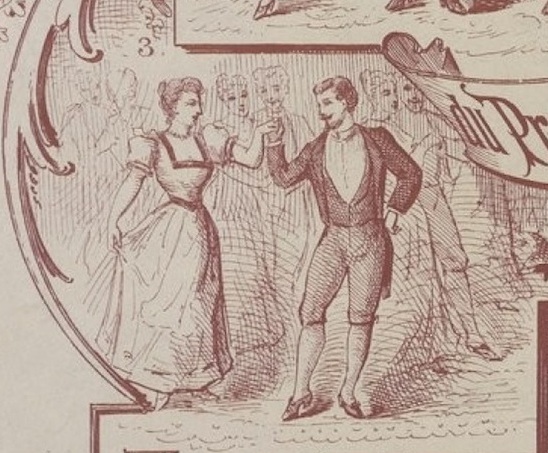 La Galopade is a short, simple sequence dance created by French dancing master, choreographer, and author Eugène Giraudet and preserved in the enormous 55th edition of his dance manual, La danse, la tenue, le maintien, l’hygiène & l’éducation (c1900) as well as in his 1913 Méthode moderne pour bien apprendre la danse. A matching description appears in George Washington Lopp’s La Danse (Paris, 1903).
La Galopade is a short, simple sequence dance created by French dancing master, choreographer, and author Eugène Giraudet and preserved in the enormous 55th edition of his dance manual, La danse, la tenue, le maintien, l’hygiène & l’éducation (c1900) as well as in his 1913 Méthode moderne pour bien apprendre la danse. A matching description appears in George Washington Lopp’s La Danse (Paris, 1903).
In the companion volume to La danse, Traité de la danse (c1900), Giraudet dates the dance to 1889; its earliest appearance may have been on the accompanying sheet music by composer Félix Chaudoir.
The dance itself is consistent across the sources and entirely straightforward to reconstruct. The dancers start side by side, as shown above (click to enlarge), inside hands held high, gentleman’s left hand on his hip (palm out) and lady’s right hand holding her gown. They start on “outside” feet (his left, her right). Couple follows couple around the room in a line or circle.
Because it moves against line of dance, La Galopade is best done by the room as a whole, rather than as a variation in a normal galop or polka.
La Galopade (16 measures)
2b Polka forward, side by side
1b Polka in place, turning half round individually to face against line of dance, changing hands
2b Polka forward, side by side, against line of dance
1b Polka in place, turning half round individually and coming together in normal closed hold
2b One bar of galop and one bar of polka (= four-slide galop); half-turn
6b Repeat galop/polka (four-slide galop) sequence three more times; one and a half turns
2b Polka; one complete turn
Open to original position holding inside hands and restart from the beginning.
Performance and Reconstruction Notes
La Galopade follows the classic sequence dance pattern: go this way, go that way, take closed position and turn. But it has a slight twist in how the pieces break down: 3b/3b/8b/2b. This pattern is not particularly intuitive for dancers, so I’ve broken it above at the more typical eight-bar point, separating the first galop/polka combination from the next three. I would recommend practicing the first eight bars as a unit several times to get the three-three-two fixed firmly in memory.
Giraudet’s galop and polka are both smooth, without hops. The preparation for the polka step is simply raising the free foot behind, and the steps themselves are described as “glissades”. I know it is difficult for experienced dancers to completely suppress the initiating hop (temps levé), but it should at least be minimized. This makes each combination of one bar of galop and one bar of polka in the dance into, effectively, a four-slide galop: slide-close-slide-close / slide-close-slide-(pause), with a half-turn on the final slide.
The individual half-turns are made toward one’s partner, not “casting” away.
Music
Félix Chaudoir’s music for La Galopade is held at the Bibliothèque nationale de France; a copy may be ordered here. Having no immediate need for it, I have not purchased a copy myself, but in La danse, Giraudet stated that the dance was in 2/4 time and that one must either begin the dance with the first measures of the music immediately following the introduction or else wait eight or sixteen more measures.
Interestingly, Lopp listed the dance as a “Galop et Polka” and described the music as “6/8 Galop et 2/4 Polka”. I’m not sure whether that “and” (et) ought to be “or”, meaning one can dance it to either type of music, or whether Giraudet described the music incorrectly and the Chaudoir music actually alternates time signatures (this seems unlikely), or whether Lopp had in mind some other piece of music that somehow attached itself to the dance.
In the absence of Chaudoir’s music and the ambiguity of Lopp’s listing, I am comfortable dancing La Galopade to any suitable music of the era. It works nicely with either galop or polka music played in the range of about 122 to 130 beats per minute, though it can be fun, briefly, to do it at higher speeds as well.
Note that while La Galopade is listed on the cover of this sheet music at the Bibliothèque nationale, from which the illustration above is taken, that is not actually the Galopade music. As was common practice in the nineteenth century, La Galopade was published as the third in a series of three pieces which all used the same cover page. The actual music there is for a different Giraudet dance.
Special thanks to Margarita for helping dance-test La Galopade!


Leave a Reply